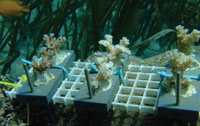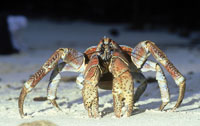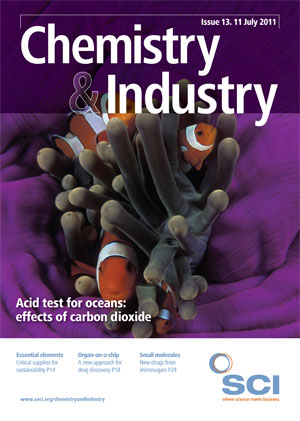Oceans do a good job of removing CO2 from the atmosphere but many marine organisms are paying the price. The International Panel on Climate Change has estimated that every day the oceans soak up over 25mt of CO2 produced by burning fossil fuels. This is having an effect on ocean chemistry, making the waters more acidic and reducing the levels of calcium carbonate minerals needed by many marine organisms to build shells and skeletons. Using models and modern sea data, the average surface pH of seawater is estimated to have dropped from 8.2 by 0.1 units since the 1900s and is predicted to fall to about 7.8 by 2100. ‘For the next few decades, we have a pretty good idea of what is going to happen. As models go, the chemistry of the oceans can be predicted pretty well,’ says Scott Doney, from the Woods Hole Oceanographic Institution in Massachusetts, US.
Ocean chemistry
Carbon dioxide dissolves in seawater to form carbonic acid, H2CO3, which rapidly dissociates to give H+, bicarbonate (HCO3–) and carbonate (CO32–) ions. The carbonate system acts as a buffer for ocean acid–base chemistry. Thus adding CO2 to seawater pushes up the hydrogen ion concentration and drives down pH (pH = –log10[H+]. As CO2 dissolves, carbonate ions (CO32– ) pull out some of the H+ ions. Unfortunately, the resulting drop in levels of carbonate ions is not good news for the corals and other calcifying organisms that need them to build hard structures.

The drop in carbonate levels affects organisms in different ways. Tropical corals are particularly susceptible and, as reef structures weaken and disappear, the many fish species which depend on them are also affected. For other species, the damaging effects are more subtle. For example, recent studies on clownfish by an international team led by Stephen Simpson at the University of Bristol, UK, found evidence that CO2-enriched waters can damage fish hearing by hindering the growth of carbonate structures in the inner ear. The clownfish uses a suite of sensory capabilities to navigate through life. Hearing is crucial, especially around coral reefs, where ‘clicks and chirps’ guide the fish to a good habitat while helping it to steer clear of predators. Simpson’s team found that fish raised in ambient-CO2 waters steered clear of tank areas where a sound recording of a reef rich in predators was played whereas those raised in high- CO2 waters swam on regardless.
‘For some organisms it is the actual reduction of pH that is stressful to them,’ says Chris Langdon from the University of Miami's Rosenstiel School of Marine and Atmospheric Science in Florida, US. ‘For simple organisms, when you change the pH of the external environment it forces the chemistry inside the body to change as well. They have mechanisms to compensate for that but it takes additional energy. That energy is then not available to put into reproduction so it has knock-on effects.’
Natural gas
‘The ocean chemistry is well understood but on the biology side a lot of what we know is based on what I call fish-tank experiments,’ says Doney. ‘You take a crab or an oyster or a piece of coral, put it into an aquarium and change the conditions to see what happens to the physiology. But to get to the next stage we need to know what is happening in wild populations in the environment.’
Jason Hall-Spencer, from the University of Plymouth, UK, is doing just that, ‘looking at how entire ecosystems have shifted in coastal waters’. He is part of an international collaboration to break new ground with a study of entire marine communities around cold volcanic vents in the sea bed, which naturally emit CO2. Since 2006, the team has worked off the rocky coast of Castello Aragonese in Italy’s Gulf of Naples, where vents cause a pH gradient in the seawater from 8.2 to 6.1.
Together with researchers from France, Israel, the UK, and Italy, Hall-Spencer has documented how coral biomass declines and snail shells dissolve in the acidified waters near the vents, which also prove too much for sea urchins with their magnesium calcite skeletons (Nature, 2008, 454, 96). As CO2 levels ramp up, some species become dominant while others recede. For example, seagrasses thrive, as does a diverse range of seaweeds that continue to photosynthesise even at extremely high CO2 levels (Journal of Experimental Marine Biology and Ecology, 2011, 400, 278).
‘Invasive alien species may end up thriving,’ says Hall-Spencer. The seaweeds travel thousands of kilometres in the ballast water of ships. ‘Species that can survive transit in ballast water are likely to be able to put up with the acidified conditions,’ he says. Next, Hall-Spencer is keen to study the acidtolerant species in fine detail to help understand which marine organisms will proliferate with increasing CO2 levels.
‘I would like to take species that live in naturally high CO2 environments to see if they are genetically different to those that live in normal CO2 environments and whether they have been somehow selected for those areas and undergone a genetic adaptation,’ he says.
Langdon has also been studying ecosystems around cold CO2 vents in Papua New Guinea, as part of an international team from the University of Miami, the Australian Institute of Marine Science and the Max-Planck Institute for Marine Microbiology in Germany (Nature Climate Change, doi: 10.1038/NCLIMATE1122). At reduced pH, the team found less coral diversity although overall coral cover remained constant between pH 8.1 andpH 7.8. The area covered by ‘structurally complex corals’ reduced three-fold while cover from the simpler massive Porites corals doubled, although they had a paler appearance in regions with higher levels of CO2. Again, seaweed and seagrass populations thrived in the acidified waters.

‘The fact that a few species do well under low pH conditions is a little encouraging,’ says Langdon. ‘It raises the question: why can’t more species do it?’ Langdon intends to focus on what makes some species more tolerant to low pH. ‘Could you maybe do genetic engineering to invoke those traits,’ he asks. ‘It might be a solution down the road.’
The team would also like to return to Papua New Guinea with more apparatus to study the ecosystems and water for a longer time, says Langdon. ‘There is a lot of other biota that we need to look at,’ he says.
Coastal chemistry
Although the acidification of the open oceans is well documented, researchers know far less about coastal chemistry and biology. ‘The coastal environment is more heterogeneous,’ says Doney. ‘You can go out into the open ocean and make a measurement every 100km or so and get a pretty good idea of what is going on. In coastal waters you either have to go out in ships fairly frequently or you need instruments on moorings or robots moving around making higher frequency measurements.’
Many coastal waters have a naturally low pH, which is amplified by acid rain and run-off of nutrients, particularly nitrogen and phosphorus, from the land and also from human waste. Cold, deep water travels along the coast in what are known as upwelling zones. Since cold water takes up CO2 more efficiently than warm water, the upwelling water is more acidic.
‘We are now realising that upwelling has profound consequences for the chemistry of our coast,’ says Ryan Kelly, at the non-partisan thinktank, the Center for Ocean Solutions at Stanford University, US. Add in effluents and you have a ‘perfect storm’ he says. Unfortunately, upwelling and effluents come together to cause acidification in coastal regions that we depend on most for fishing and tourism.
‘On a local scale, particularly for coral reefs, there are actions that can be made to protect against acidification, for example, by reducing overfishing and local pollution sources such as runoff,’ says Doney.
‘People need to be aware that what they do in coastal drainage areas affects the ocean,’ he says. For example, when nutrients from household and agricultural fertilisers wash into the sea they can cause algal blooms. As bacteria munch their way through the algae that die, oxygen levels fall and carbon levels go up. ‘These low oxygen zones are also regions of acidification,’ says Doney. Worldwide, more than 400 coastal areas are very low in oxygen or hypoxic. For example, increased wind-driven upwelling off the Oregon–Washington coast is linked to the first appearance of hypoxia there in five decades.
‘There is a lot that can be done to protect our local habitats,’ says Doney. He gives the example of oyster farms off the North American west coast, which had been suffering from highly acidic water being blown inshore. A monitoring system out at sea now alerts the aquaculture hatcheries when acidified water is heading their way so that they can stop taking in fresh seawater.
Kelly is fairly upbeat after his team’s recent analysis of ocean acidification publications. ‘The heartening thing is that we have local problems,’ he says. ‘Up to half of the acidification in coastal areas might be local in source instead of coming from global CO2. It stands to reason that we can address those problems locally’ (Science, 2011, 332, 1036). Freshwater inputs, pollutants, and soil erosion can acidify coastal waters at substantially higher rates than atmospheric CO2. In the US, Kelly is confident that enforcing existing local laws could help considerably, including those that set emissions limits for pollutants such as nitrogen dioxide and others dealing with residential and agricultural run-off.
As part of the Stanford-led study, George Waldbusser from Oregon State University in the US points to his work on clams in the Chesapeake Bay region on the East coast. He has shown that returning crushed shell material to local habitats can increase pH ‘substantially’ and lessen the impact of local acidification on clam populations. ‘If you think of there being a pH budget – a range within which ecosystems can exist – there are lots of ways of overspending this budget,’ says Kelly. ‘This is one way of trying to keep an ecosystem within its pH range, within its budget. It makes a lot of sense.’ Such a measure is small and most researchers in the field call for urgent reductions in global CO2 emissions. Langdon also thinks that ‘urban sequestration technologies’ need to be developed.
‘Now that we have a critical mass of publications, we are starting to be heard,’ says Kelly. Langdon agrees that it has taken a long time to attract global attention to ocean acidification. ‘Even in my own environmental field, people don’t want to divert attention away from global warming, which they see as a more immediate threat to coral reefs,’ he says. ‘But warming and acidification go hand in hand. The solutions are the same so why try to argue that one is more important than the other?’ Langdon likes to think of corals as ‘sentinel species’. ‘They are more sensitive than other things to ocean acidification. We can pay attention to these warnings or not, but gradually as the pH drops other ecosystems close to home we will feel the impact.’
Emma Davies is a freelance science writer based in Bishop's Stortford, UK.




